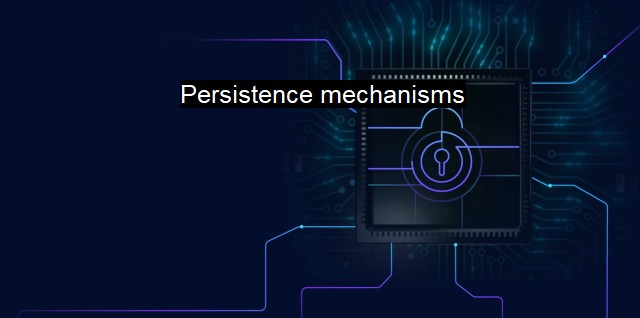What are Persistence mechanisms?
Securing Computing Systems: Understanding the Critical Role of Persistence Mechanisms in Cybersecurity and Antivirus Solutions
The term "Persistence Mechanisms" often surfaces. It generally refers to techniques that hackers and malicious software (malware) employ to maintain their presence and activities in a computing ecosystem even after systems reboot or antivirus software efforts to remove them.Persistence mechanisms, a term widely recognized within the cybersecurity community, can be equated essentially to survival tactics these malwares employ against multiple assaults, aimed at eliminating their presence. This concept is not unique to the cyber domain though it has more sinister implications and consequences here.
Hackers often use malware to penetrate a targeted system. Once the malware becomes deeply embedded within the host's system, it gains the ability to continue its operations - undeterred by certain security measures. This ability to sustain its operations, come what may, is attributed to the employment of persistence mechanisms.
These persistence mechanisms are strategies that allow malware or a hacker to continuously exert their influence on a system even after attempts to disrupt or clean their influences. Persistence mechanisms can materialize in the form and disguise of seemingly legit processes, services, registry entries, or files, thus evading obvious detection. This makes them increasingly complex to identify and resolve hence possessing an insidious presence within a system.
For instance, a simple form of persistence mechanism is achieved when malware sets itself to automatically launch whenever the infected computer starts. This way, even if the malware is deleted during an active session, it can reinstall itself upon a system reboot, renewing its operation. Consequently, these uncomplicated persistence mechanisms present considerable hindrances for antivirus software designed to completely eradicate the malware from a vulnerable system.
Also, persistence mechanisms can be as complex as kernel-level rootkits designed to alter low-level systems processes while remaining declined to antivirus software. Most of these malware infestations with advanced persistence mechanisms can even survive full system reboots or hard resets.
With the growing sophistication in cyber-threat landscapes, more advanced forms of persistence mechanisms are now being identified. Some of these include zombies and botnets. Herein, an infected computer in a network (called a zombie) is controlled remotely to conduct malicious activities, thereby ensuring sustained malicious presence (persistence) in a network (botnet).
Another well-recognized persistence mechanism is found in advanced persistent threats (APTs). These are long-term targeted attacks where hackers gain unauthorized access to a network and remain undetected for lengthy periods, causing substantial damages.
In the face of such persistent threats, cybersecurity efforts have to level up too. There's a dire need for businesses to install next-gen antivirus software capable of continually monitoring and observing these malicious, constantly altering codes. employing behavioral, heuristics-based analysis methods might aid in understanding the pattern of leading malware and predicting, preventing future attacks.
Organizations can implement other comprehensive cybersecurity strategies such as adopting better system hygiene, endorsing the principle of least privilege, enforcing stronger password policies, active monitoring of network traffic, hosting regular cybersecurity training for personnel, and keeping systems up-to-date to ensure stronger resistance against these constantly evolving persistent threats.
Understanding persistence mechanisms in cybersecurity is pivotal in comprehending the degree of tenacity root-level malware infections can have within information systems. Hence, it is essential in developing more persistent resistance strategies and adjustable antivirus defenses needed to counteract present and futuristic cyber threats. Despite the advantages persistence mechanisms give hackers, staying one step ahead in cybersecurity remains paramount. This demands understanding the current cyber threats, employing adaptive security apparatus, and having an ever-evolving strategy – presumably, an organic persistence mechanism in cybersecurity.

Persistence mechanisms FAQs
What is a persistence mechanism in cybersecurity?
A persistence mechanism is a technique used by cybercriminals to maintain access and control over a compromised system even after rebooting or restarting. It involves creating a backdoor or a hidden method of entry into a system, allowing the attacker to come back and execute further malicious activity.What are the common types of persistence mechanisms used by cybercriminals?
Some common types of persistence mechanisms used by cybercriminals include registry keys, scheduled tasks, services, startup programs, and driver installation. These techniques allow the attacker to execute their malicious code at various stages of the boot process, thereby ensuring persistent access to the system.How do antivirus programs detect and prevent persistence mechanisms?
Antivirus programs use signature-based detection and behavioral analysis to detect and prevent persistence mechanisms. They can recognize known signatures of malware that use persistence methods, and they can analyze system activities to identify suspicious behavior that could indicate the presence of a persistence mechanism. Once detected, antivirus programs can quarantine and remove malicious files and registry keys to prevent further damage.What can organizations do to protect against persistence mechanisms?
Organizations can reduce the risk of persistence mechanisms by implementing security best practices such as regular patch management, limiting user privileges, and using endpoint security solutions. They should also conduct regular security assessments to identify and remediate vulnerabilities and engage in ongoing security awareness training to educate employees about the risks of cyber threats.| | A | | | B | | | C | | | D | | | E | | | F | | | G | | | H | | | I | | | J | | | K | | | L | | | M | |
| | N | | | O | | | P | | | Q | | | R | | | S | | | T | | | U | | | V | | | W | | | X | | | Y | | | Z | |
| | 1 | | | 2 | | | 3 | | | 4 | | | 7 | | | 8 | | |||||||